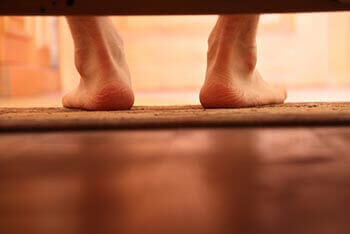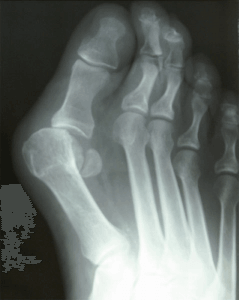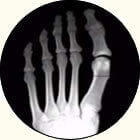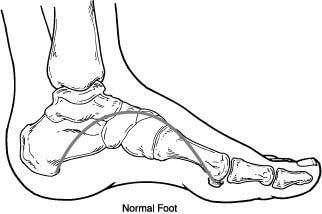bfdadmin
bfdadmin
Dr Brandon Nelson, A Board Certified Physician & Surgeon, Discusses Chronic Heel Pain and How to Get Rid of It

The number one cause of heel pain is Plantar Fasciitis. Plantar Fasciitis is an inflammation of a band of tissue on the bottom of one’s foot. The most common reason is overuse. Overuse can come in many forms, people that work on their feet, or avid exercisers and even just long term wear and tear on your feet. It is important to know that your fascia is the main supporting network of one’s feet and is under chronic mechanical load.
It is important in the process of trying to cure plantar fasciitis to identify any outlying reasons for fasciitis. These outliers can be systemic causes, training errors or general overuse injuries. I think an x-ray is always warranted as well as an overall skeletal exam. The earlier one sees a foot and ankle physician the faster we can get you on the road to recovery.
Once an exam has been performed the next stop is how do we fix the underlying causes and cure the fascia long term. There are many options you can read about but the mainstay is reducing mechanical burdens and inflammation. I have a protocol I have used for more than 10 years and on 1000’s of patients. The majority of my patients are 50-70% better within the first week of seeing me.
Then there are the patients that have chronic fasciitis or long term fasciitis. The workup for these patients should be a little different and more extensive. Once plantar fasciitis has been identified as the root problem more advanced modalities will usually cure the fasciitis. The focus of these modalities is usually to stimulate one’s own biology to actively heal the underlying inflammation. These are some of the most cutting edge techniques and technologies available and our office has the 2 most effective modalities to fix your heel pain.
If you have heel pain, schedule an appointment with me, Dr. Nelson and I will get you fixed and ready to enjoy your summer! Give us a call at 425-391-8666 or make an appointment online.
Voted by Holistic Magazine as a top holistic provider.
Sincerely,
Board Certified Physician & Surgeon
Dr Brandon Nelson, A Board-Certified Physician & Surgeon Discusses How the Lapiplasty Bunionectomy Works

A bunion is a common foot condition I see at my clinic. It is amazing the different sizes and shapes of bunions I have seen during my career. There are a couple of things I have noted during this time. One is that the bunion gets bigger. It does not grow but the bone continues to move out of alignment. Secondly it is easier to fix earlier in the process especially when the other toes are not involved. Lastly, the most important aspect is proper procedure selection. This leads me to my discussion today. The Lapiplasty has really revolutionized bunion surgery.
I was listening to a lecture today and they were discussing the fact that there are over 150 different types of bunion surgery. Most of these techniques are no longer utilized. But this is important because it illustrates how difficult it can be to get long term corrections. This is why I am a fan of the Lapiplasty procedure. The Lapiplasty corrects the bunion at its apex. It helps to realign the bone in all 3 cardinals planes that the body moves in. It has helped surgeons to provide the best correction for the patient and speed recovery. I find this procedure has incredible outcomes and my patients are happy with their results.
If you are suffering from a bunion I can help. I have seen how painful and debilitating these can be. Make an appointment online or give us a call at 425-391-8666
Sincerely,
American College of Foot & Ankle Surgeons
Dr Brandon Nelson, A Board Certified Physician & Surgeon, Discusses Recovery from the Lapiplasty Bunion Surgery
.jpg)
I have seen many types of bunion surgery after operating and practicing now for 15 years. Surgical techniques change and fixation changes and surgery in general tends to improve. What I mean by improvement is outcomes get better with new research and recovery can shorten with new ideas or medical devices. The days of not walking on your surgical foot are behind us. The majority of patients I see and operate on are walking when the can tolerate the swelling and discomfort. This is different from the bunion surgeries of the past.
Historically a lot of the bunions we fixed required a long period of non-weight bearing or even an overnight stay in the hospital. This has really changed with newer techniques and the average surgery for a bunion now is about 2 hours. The other dramatic difference is the majority of patients can walk on their feet after surgery. The longest I typically instruct patients to be off their feet now is about 2 weeks. The big factor in this change is the Lapiplasty procedure and its newer fixation methods.
The Lapiplasty is based on the Lapidus bunionectomy. This is a procedure we have utilized for years with great success. However, newer instruments and fixation have advanced healing and outcomes. I truly love utilizing the lapiplasty to fix bunions and have seen incredible results. If you are suffering from bunion pain I can help! Give me a call at 425-391-8666 or make an appointment online today.
Sincerely,
American College of Foot & Ankle Surgeons
Dr Brandon Nelson, A Board Certified Physician & Surgeon, Discusses How to Fix Your Bunion

Bunions can be extremely painful. They can make everyday activities uncomfortable. These can be things like running or hiking or climbing or even just trying to wear shoes. The pain is often described as a dull ache or even a burning type sensation. Plenty of patients relate other things like trying to wear a shoe again after being in a sandal all summer or a sudden sharp pain on the bottom of their foot. The symptoms and problems associated with a bunion can be diverse and understanding the pathology can be helpful.
A bunion is not a growth on the side of the foot. Quite a few patients come into the office believing that they have a bony growth that is causing the bunion. However this is a common misconception. The bunion is caused by a change in position of the 1st metatarsal bone. This bone begins to deviate towards the other foot and as it changes position the big toe drifts towards your 5th digit or pinky toe. This deviation gets worse with time. There are factors that influence the bunion. Primarily it is genetics. Your bunion develops because one has a family history of bunions. There are factors that will increase the speed at which it occurs like high heel shoes for example. Eventually it becomes big enough or painful enough to have it fixed.
Fixing a bunion is my specialty. I really enjoy helping patients to get back to the activities they love. Bunion surgery can be relatively straightforward and provide excellent results. The vast majority of bunions can be fixed in 1-2 hours as an outpatient procedure. The surgical recovery depends on the procedure selected and the fixation utilized to repair the bunion. If you are suffering from bunion pain I can help! Give me a call at 425-391-8666 or make an appointment online today.
Sincerely,
American College of Foot & Ankle Surgeons
Dr Brandon Nelson, A Board-Certified Physician & Surgeon Discusses Bunions and When to Fix Them

Bunions come in all shapes and sizes. I have seen very large ones that are not painful and very small ones that are painful. It is amazing how it can really be all over the spectrum and size and pain do not always coordinate. The most important first step regardless of pain is to have them evaluated.
The evaluation should be done by a bunion expert. I have spent years and time with 1000s of patients evaluating bunions. I can now say some do very well with conservative care and some require surgery. I always recommend x-rays and looking at the rest of the foot to see if it is affected. Sometimes as the bunion gets bigger the smaller toes begin to curl and hammer. It is paramount to appreciate the rest of the foot and its function as well.
The treatment for bunions is not all the same. The treatment depends on individual foot structures, bone quality and lifestyle or activity levels. If you are suffering from bunion pain, I can help. I have seen how painful and debilitating it can be. Make an appointment online or give us a call at 425-391-8666 today.
Sincerely,
American College of Foot & Ankle Surgeons
Dr Brandon Nelson, A Board-Certified Physician & Surgeon Discusses Heel Pain

Heel pain can come on very suddenly. I remember when I first had heel pain and could hardly get out of bed. That first step in the morning was brutal. It would take hours for my heel to calm down. Then every time I sat down and got back up it would start. It was a terrible cycle that felt like it would never stop. Well, this really helped me to understand how patients were feeling. It also helped me come up with a treatment protocol that speeded recovery and permanently get rid of heel pain.
Most of all heel pain is plantar fasciitis. The plantar fascia is a thick fibrous tissue that is the main supporting structure of the foot. It helps with all phases of gait. It is chronically under load and tension and is the workhorse of the foot. This is why it can be so common to have heel pain. It is believed that something like 60% of all adults will experience heel pain at some point in their lives.
The treatment protocol I developed took me years to perfect and 1000s of patients. All heel pain is not the same just as all foot structures are not the same. If you are suffering from heel pain, I can help. I have seen how painful and debilitating it can be. Make an appointment at 425-391-8666 or contact us online.
Sincerely,
Dr Brandon Nelson, A Board-Certified Physician & Surgeon Discusses Neuromas

Do you have pain and or burning in one of your feet? Have you felt like maybe your sock is balled up in the front of your shoe or you are walking on a pebble? Do you find yourself taking off your shoe and sock to rub your forefoot? If these symptoms sound familiar you could have Morton’s Neuroma. This is a common condition that presents between the ages of 40-60.
A neuroma is a condition that occurs when a nerve is irritated in the foot and can swell. This normally occurs in the 3rd interspace of the foot. This is because the large nerve in the ankle that supplies the innervation to the foot divides into two branches. These two branches are the medial and lateral plantar nerves of the foot. These then come together in the 3rd interspace and create a spot of compression. Most physicians believe that this area lacks enough space and with ambulating the nerve can become irritated and a neuroma can develop.
Once a neuroma develops it can be very challenging to get the nerve to calm down. I have seen all sorts of creative solutions by patients but there are some tried and true methods. The first seems to be offloading of a nerve. Specifically, a prescription orthotic that is custom made for your anatomy works very well. This will need to be done by a physician, a shoe store or non-physician does not have access to the correct technology or laboratory equipment nor the training. Secondly, alcohol injections provide incredible relief to the irritated nerve. There is a great long-term study that shows this is effective up to 89% of the time.
If you are suffering from what you believe is a neuroma I can help. I have seen how painful and debilitating these can be. Make an appointment at 425-391-8666 or by filling out a contact form online.
Sincerely,
Dr Brandon Nelson
American College of Foot & Ankle Surgeons
Dr. Timothy Young Discusses Bunion Surgeries Part 3
.jpg)
Dr. Timothy Young Discusses Bunion Surgeries Part 3
After the surgery Dr. Young likes to keep close tabs on his patients' and their recovery. It is important that any post procedure pain is well-controlled. It is also important that they have proper instructions beforehand, so they are prepared at home when all the anesthetic wears off. This is where being a couch potato pays off. Keeping the feet elevated, using ice, and taking medication as prescribed is critical. It is also critical to protect the surgical site either using a special boot, splint, crutches, or scooter. All the presurgical advice like getting a shower protector keeping the dressing intact to protect the surgical site comes into play. At each postoperative visit, the surgical site is checked to make certain it is healing properly and that there are no signs of infection.
Post acute recovery involves:
This involves bone remodeling and healing and soft tissue remodeling and healing. Sutures are removed. Post procedure x-rays are taken to verify the correction is maintained and that the bones are starting to bridge together properly. Our patients take special bone healing supplements also. We also often work with outside physical therapy clinics to help our patients heal faster and obtain proper range of motion and strength.
In conclusion, preparing for bunion surgery requires a comprehensive approach that considers the patient’s medical history, the extent of the deformity, and the type of surgery required. A skilled surgeon will carefully plan the surgery, provide detailed instructions for pre- and post-operative care, and closely monitor the patient’s recovery to ensure the best possible outcome.
If you are experiencing foot or ankle pain, give us a call at 425-391-8666 or make an appointment online today.
Dr Timothy Young Discusses Bunion Surgeries, Part 2

Dr Timothy Young Discusses Bunion Surgeries, Part 2
Operating Room Preparation
Dr. Young and his staff will prepare the operating room by ensuring that the required equipment is sterilized and ready for use. This includes special surgical instruments that Dr. Young utilizes specifically for bunion correctionsurgery along with other standard surgical instruments. Also, surgical drapes, and other materialsrequired for the surgery. Dr. Young and the surgical team will also put on sterile clothing and gloves to reduce the risk of infection
Surgical Procedure
At the time of surgery, the correct surgical location is verified. IV antibiotics are administered by the anesthesia staff. The foot is prepped by a surgical scrub tech. Dr. Young will then do a final antibacterial scrub, in combination with sterile drapes placed around the foot isolated and protect the foot from infection.
Dr. Young will then start by making incisions on the foot to access the bunion. Dr. Young is careful and meticulous going down through the soft tissue layers over the bunion. Enlargement of the bunion itself (bone) is removed. Dr. Young then performs the bunion realignment surgery. You can think of this as resetting the bones like a surgical fracture. Just like a fracture, once the new position is exactly where Dr. Young wants it, he then uses any needed combination of pins screws and plates to maintain the correction. The hardware (screws plates and or pins) is used to hold the bones in place during the healing process.
This is also where the art of surgery comes in. For example, after realigning the first metatarsal, if the great toe is still out alignment, then additional correction is necessary. This needs to be done at the time of surgery. Additional release of lateral soft tissue structures can be done. An additional procedure called an Akin can be done. There are several options, and this is where it is critical to make sure that the foot is fully corrected before the dressings go on and the surgery is complete. Dr. Young will also use intraoperative fluoroscopy (which is a form of x-rays) to verify the bones and correction are exactly where he wants them. When our patients first see their bunion correction after surgery. We want to make sure that they are happy, and that the bunion is fully corrected. This also helps to minimize the risk of recurrence of a bunion.
If you are experiencing foor or ankle pain, give us a call at 425-391-8666 or make an appointment online.
Dr Timothy Young Discusses Bunion Surgeries

Dr Timothy Young Discusses Bunion Surgeries in Detail, Part 1
Bunion surgery is a common procedure performed by Dr Timothy Young and other Foot Surgeons to correct a bunion deformity. A bunion is usually combination of the first metatarsal being out of alignment and bony bump that forms on the joint at the base of the big toe. This can cause pain and discomfort when walking or wearing shoes. The bunion correction surgery itself usually takes 1-2 hours. The surgeon’s preparation for bunion surgery requires planning ahead and, requires attention to detail. In this blog, we will go over the steps that Dr. Young and other foot surgeons take to prepare for the best bunion treatment and the best bunion surgery.
Patient Evaluation
Before any bunion surgery, Dr. Young will evaluate the patient's medical history, medications, and overall health to make sure that our patients are good surgical candidates. Dr. Young will also examine the patient's foot to determine the severity of the bunion, the extent of the deformity, and the type of bunion surgery that would be most appropriate. For example, some patients have a severe bunion deformity and require a Lapidus or Lapiplasty procedure. Some patients have extreme adaptation of the great toe joint and require a procedure that realigns the joint. Some bunions are mild and yet the joint is not flexible and for this, decompressing the joint is an effective treatment. These evaluations come from both physically examining the foot, and imaging evaluation.
Imaging Tests
The surgeon will typically order imaging tests such as X-rays, CT scans, or MRI scans to get a better understanding of the bunion’s structure and position. This information will help the surgeon plan the surgery and determine the best approach to correcting the deformity. Dr. Young uses digital x-rays which allow for precise measurements and preoperative planning that can be done right on the computer.
Anesthesia Planning
Dr. Young will discuss the anesthesia options before surgery. Dr. Young often utilizes local anesthetic combined with MAC anesthesia (monitored anesthesia with conscious sedation). Other options include general anesthesia, regional anesthesia, or local anesthesia. The type of anesthesia can be discussed prior to surgery and will depend upon the patient's medical history and the type of foot surgery and the extent of bunion surgery. With MAC anesthesia combined with local anesthetic, the patient is still conscious and breathing on their own (not intubated). This is more like a twilight sleep and the patient's recovery extremely fast, and we can avoid the typical side effects that can be encountered with the general anesthetic.
The preoperative visit:
Dr. Young's patients come in the week prior to surgery to help them prepare for surgery. We will discuss details of the surgery itself and how to care for the foot after bunion surgery and if crutches or a special boot will be required. Also, the patient's medical history and medications are reviewed. Some medications will be avoided prior to surgery. Usually, the patient will be required to fast prior to surgery and need to make driving arrangements after the procedure. Our patients are given a special antibacterial scrub to do at home prior to surgery.
If you are experiencing foor or ankle pain, give us a call at 425-391-8666 or make an appointment online.



